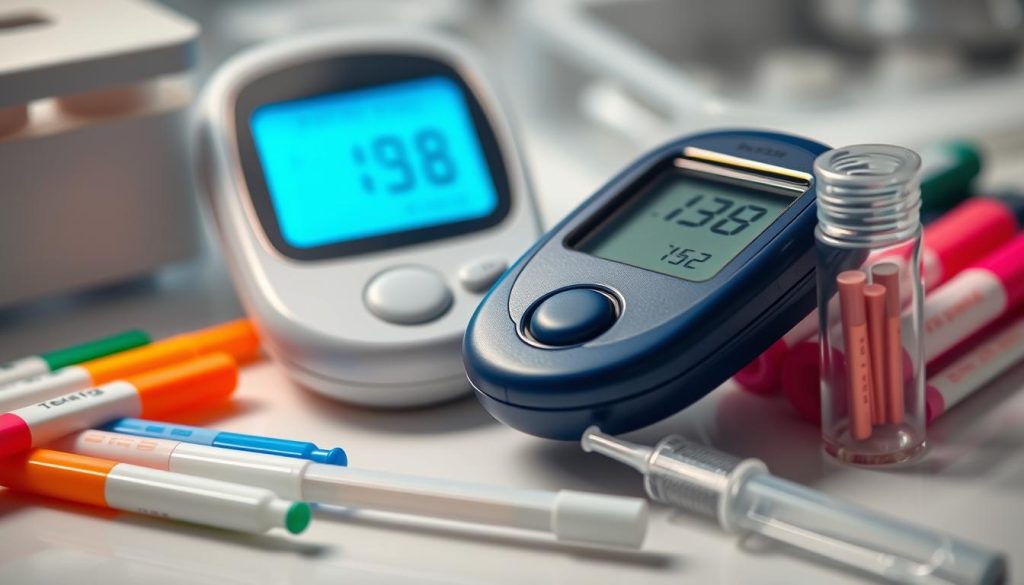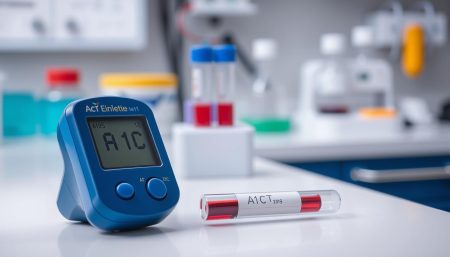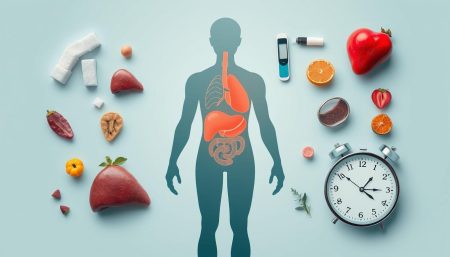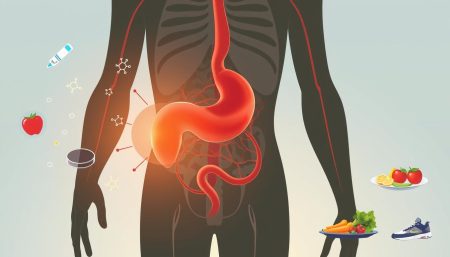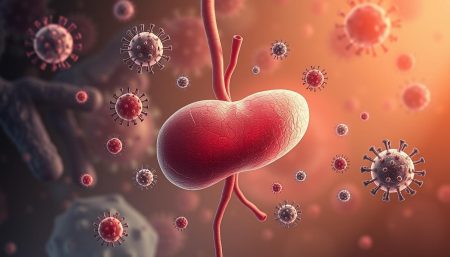Endocrine disorders can be complex and nuanced. It’s important to understand the differences between diabetes mellitus vs diabetes insipidus. These conditions have distinct causes and symptoms. Diabetes mellitus is linked to insulin issues and high blood sugar. On the other hand, diabetes insipidus is caused by kidney problems and leads to excessive urine production.
People with diabetes may face more than just internal symptoms. They can also experience external signs. A study on diabetes and hair loss shows how these conditions affect our appearance. This highlights the broad effects of diabetes on our health.
Introduction: Understanding Diabetes
Diabetes is a group of conditions where the body can’t keep blood sugar levels healthy. It’s key to know the main types of diabetes and their symptoms. This helps in managing and preventing the disease.
When we look at diabetes, it’s important to understand the diabetic condition differences. For example, diabetes mellitus and diabetes insipidus are two different conditions. They have different causes and treatments.
Diabetes mellitus is when the body can’t make enough insulin or use it well. This leads to high blood sugar. Diabetes insipidus, on the other hand, is about kidney or hormone problems. It causes dehydration if not treated right.
Knowing the diabetes mellitus symptoms is important. These include needing to pee a lot, feeling very thirsty, and having high blood sugar. It’s important to tell these symptoms apart from others to get the right treatment.
This talk aims to clear up confusion and highlight the important differences between each type of diabetes. It’s all about understanding each condition better. This helps both patients and doctors.
Diabetes Mellitus vs Diabetes Insipidus: Unveiling the Confusion
Diabetes can be confusing because of different types like diabetes mellitus and diabetes insipidus. Knowing the causes of each is key for correct diagnosis and treatment.
The Fundamental Causes Behind Each Condition
Diabetes mellitus happens when the body can’t make or use insulin well. Insulin is important for controlling blood sugar. In contrast, diabetes insipidus is about the kidneys not responding right to a hormone called ADH or not making enough ADH. This affects how the body handles water.
Prevalence and Public Awareness of Diabetes Types
Diabetes mellitus is well-known and affects more people. This is because of big health campaigns and education. But, diabetes insipidus is rare and not as well understood. We need more awareness and education to help people know the difference.
| Diabetes Type | Prevalence | Public Awareness Level |
|---|---|---|
| Diabetes Mellitus | High | Widely Recognized |
| Diabetes Insipidus | Low | Limited Awareness |
What is Diabetes Mellitus?
Diabetes mellitus is a long-term condition where blood sugar levels are too high. It comes in two main types: Type 1 and Type 2. Each type has its own causes and ways to manage it.
Exploring Type 1 and Type 2 Diabetes Mellitus
Type 1 diabetes often starts in kids and young adults. It’s when the body doesn’t make enough insulin. Insulin helps glucose get into cells for energy.
Type 2 diabetes usually starts in adults. It’s when the body can’t use insulin well, leading to insulin resistance.
Diabetes Mellitus Symptoms and Management
Common diabetes mellitus symptoms include needing to pee a lot, being very thirsty, feeling tired, and blurry vision. Spotting these symptoms early is key to managing the condition well.
| Condition | Symptoms | Management Strategies |
|---|---|---|
| Type 1 Diabetes | Increased thirst, frequent urination, hunger, fatigue, blurred vision | Insulin therapy, carbohydrate counting, frequent blood sugar monitoring |
| Type 2 Diabetes | Often similar to Type 1, may also include slow healing of cuts and bruises | Dietary changes, physical activity, medication, blood sugar monitoring |
Managing diabetes mellitus well means making lifestyle changes, watching for diabetes mellitus symptoms, and getting regular medical care. Teaching patients about diabetes and how to manage it is also important.
Delineating Diabetes Insipidus
Diabetes insipidus is a unique endocrine disorder. It’s not about sugar levels but about water balance. The hormone vasopressin, key for kidney function, is not produced right. This leads to too much urine and intense thirst.
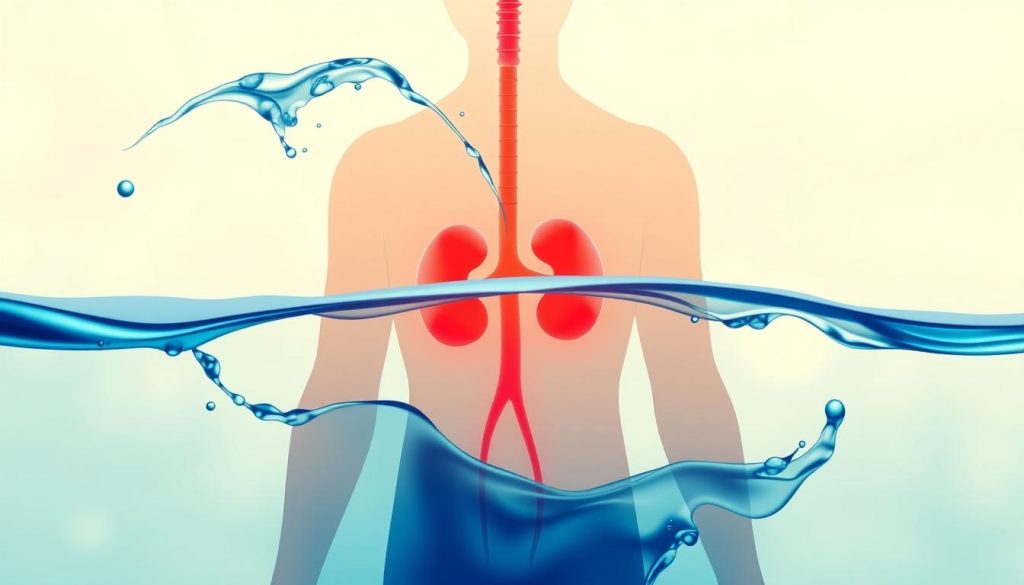
This condition is different from diabetes mellitus, which affects insulin. Diabetes insipidus is about fluid balance, not sugar. It’s caused by hormone or kidney problems. Knowing this is key to understanding endocrine disorders.
| Aspect | Diabetes Mellitus | Diabetes Insipidus |
|---|---|---|
| Primary Dysfunction | Insulin secretion/utilization | Vasopressin secretion/utilization |
| Main Symptoms | High blood sugar, frequent urination, increased thirst | Excessive urination, extreme thirst |
| Management Focus | Blood sugar control | Water and electrolyte balance |
The symptoms of diabetes insipidus are clear. You might need to pee a lot, even at night. You’ll always feel thirsty. These signs are serious and need quick action to avoid dehydration and health problems.
Diabetes Insipidus Causes and Symptoms
It’s important to understand diabetes insipidus to manage it well. This type of diabetes is different because it affects how the body handles fluids. Unlike other diabetes types, it’s not about sugar levels.
Central vs Nephrogenic Diabetes Insipidus
Diabetes insipidus comes in two main types. Each has its own causes and symptoms. Central Diabetes Insipidus happens when the brain’s parts that control water are damaged. This leads to too much urine and thirst.
Nephrogenic Diabetes Insipidus, on the other hand, is when the kidneys can’t handle water right. This also causes too much urine and thirst, similar to the first type.
- Central Diabetes Insipidus: Often caused by genetics or brain damage from surgery, infection, or inflammation.
- Nephrogenic Diabetes Insipidus: Usually caused by inherited conditions or long-term kidney disease, making it hard for kidneys to handle ADH.
Knowing the difference between these conditions is key to treating them right. It helps us understand how diabetes insipidus affects daily life. Patients need specific treatments to deal with constant urination, dehydration, and thirst.
Comparing Symptoms: Diabetes Mellitus and Diabetes Insipidus
It’s important to know the differences between diabetes mellitus symptoms and diabetes insipidus symptoms. Both can cause more thirst and urination. But, they have different causes. So, a diabetes comparison is key.
Diabetes Mellitus: This condition is caused by too much sugar in the blood. It happens when the body can’t make enough insulin or use it well. Symptoms include needing to pee a lot, feeling thirsty, hungry, tired, seeing things blurry, and wounds that don’t heal fast.
Diabetes Insipidus: This condition affects how the body handles water. It’s caused by a problem with a hormone called ADH. The main symptoms are peeing too much and feeling very thirsty. These symptoms aren’t because of high blood sugar.
| Condition | Symptoms | Primary Cause |
|---|---|---|
| Diabetes Mellitus | High blood sugar, frequent urination, increased thirst, fatigue | Insulin deficiency or resistance |
| Diabetes Insipidus | Excessive urination, excessive thirst | ADH disruption |
Healthcare providers can better help patients by comparing diabetes mellitus symptoms and diabetes insipidus symptoms. This helps them focus on the right treatments for each condition. Making these diabetes comparisons is vital for doctors and for teaching patients how to manage their diabetes.
Complications and Risks Associated with Diabetes Mellitus and Insipidus
It’s important to know the long-term health risks of diabetes. This knowledge helps in managing diabetic condition differences and avoiding severe endocrine disorders complications. Both diabetes mellitus and insipidus have their own challenges and complications. They need careful awareness and specific management plans.
Diabetes mellitus can lead to heart disease, nerve damage, kidney problems, and vision loss. These issues happen because high blood sugar levels damage blood vessels and nerves over time.
Diabetes insipidus, on the other hand, mainly affects the body’s fluid and electrolyte balance. It can cause dehydration and electrolyte imbalances. These can harm kidney function and affect cells all over the body. Unlike diabetes mellitus, its complications come from not having enough antidiuretic hormone or the kidneys not responding well to it.
| Complication | Diabetes Mellitus | Diabetes Insipidus |
|---|---|---|
| Cardiovascular Disease | High Risk | Low Risk |
| Nerve Damage | Common | Rare |
| Kidney Damage | Possible | Low risk, barring severe dehydration |
| Vision Issues | Frequent | Unrelated |
| Dehydration/Electrolyte Imbalance | Possible during hyperglycemic episodes | Common |
This comparison shows how diabetes mellitus and insipidus affect health differently. Knowing these differences is key to managing endocrine disorders complications well. It’s vital for improving life quality and preventing serious health problems in diabetic patients.
Diagnosing the Diabetic Conditions
Getting a correct diabetes diagnosis is key to managing and treating diabetes well. Both diabetes mellitus and diabetes insipidus need specific tests to tell them apart and manage them right. This part talks about the important tests that help figure out the type of diabetes and how severe it is.
Blood Tests and Glucose Monitoring
For diabetes mellitus, blood tests check blood glucose levels. The main tests are:
- Fasting Blood Sugar Test: Checks glucose after a night without eating.
- Oral Glucose Tolerance Test (OGTT): Looks at blood glucose before and after a sweet drink.
- Hemoglobin A1c Test: Shows average blood glucose over three months.
- Continuous Glucose Monitoring (CGM) Systems: Gives real-time glucose levels all day and night.
These tests help doctors make a quick diabetes diagnosis. They can then suggest the best ways to keep glucose levels in check.
Urinalysis and Water Deprivation Testing
Diagnosing diabetes insipidus needs different methods. These include:
- Urinalysis: Checks urine concentration, which is often lower in diabetes insipidus.
- Water Deprivation Test: Sees how dehydration affects urine concentration.
| Test Type | Utilized For | Description | Relevance to Diabetes Type |
|---|---|---|---|
| Fasting Blood Sugar | Diabetes Mellitus | Checks glucose after fasting | Mellitus (Type 1 & 2) |
| Urinalysis | Diabetes Insipidus | Looks at urine concentration | Insipidus |
| Water Deprivation Test | Diabetes Insipidus | Tests kidney function under dehydration | Insipidus |
| Oral Glucose Tolerance | Diabetes Mellitus | Measures glucose after sugar intake | Mellitus (Type 1 & 2) |
Diabetes Mellitus Treatment Strategies
Managing diabetes mellitus requires a mix of lifestyle changes, medication, and blood sugar monitoring. This part explores the key strategies for keeping health in check and managing symptoms well.
- Lifestyle Modifications: Eating right, staying active, and keeping a healthy weight are key. These steps can lower blood sugar levels, reducing the need for medication or insulin.
- Oral Medications: There are many oral meds to control blood sugar. It’s important to choose the right one for each person, with a doctor’s help.
- Insulin Therapy: For type 1 diabetes, insulin therapy is essential. The right dose and type of insulin are chosen based on the person’s needs.
- Monitoring Blood Sugar Levels: Checking blood sugar often is vital. It helps keep levels in a safe range. This way, diet, meds, and activities can be adjusted as needed.
These strategies need a personal touch, based on the type and severity of diabetes. Adjustments are made as the condition or lifestyle changes.
The aim of these treatments is to control diabetes and improve life quality. New tech like continuous glucose monitors and smart insulin pumps help manage blood sugar levels better and more discreetly.
Diabetes Insipidus Management and Care
Managing diabetes insipidus requires a detailed plan. Healthcare experts closely watch over it. It’s different from diabetes mellitus because it focuses on fluid balance and hormone levels, not blood sugar.
Hormone replacement therapy is key for treating central diabetes insipidus. This condition happens when the body lacks antidiuretic hormone (ADH). To fix this, doctors use synthetic ADH, or desmopressin. It’s given as a nasal spray, oral tablet, or injection, based on the patient’s needs.
- Keeping track of how much fluid you drink and how much urine you make
- Drinking the right amount of water to avoid dehydration
- Changing the medicine as needed to manage symptoms and side effects
The table below shows how hormone replacement therapy is used in managing diabetes insipidus. It shows how it’s used in everyday medical care.
| Form of Administration | Typical Dosage | Considerations |
|---|---|---|
| Nasal Spray | 10-40 mcg | Good for quick symptom relief |
| Oral Tablet | 0.1-1.2 mg | Best for long-term use |
| Injectable | 2-4 mcg | Used for severe cases in hospitals |
It’s also important to watch for side effects of hormone replacement therapy. Like hyponatremia. Regular doctor visits can greatly improve life for those with diabetes insipidus.
Living with Diabetes: Lifestyle and Diet
Managing diabetes well means making dietary changes, adjusting your lifestyle, and staying active. Each part is key to keeping blood sugar levels stable and your health in check.
Adapting Your Diet for Diabetes Management
Changing your diet is key to managing diabetes. Aim for a balanced diet that’s low in fat and calories. It should also be moderate in carbs. Here are some tips to help:
- Eat more fiber from veggies, whole grains, and legumes.
- Choose lean proteins like chicken, fish, and plant-based options.
- Add healthy fruits and veggies to every meal.
- Reduce processed sugars and refined carbs.
Here’s a look at good foods versus bad for diabetes management:
| Recommended Foods | Foods to Avoid |
|---|---|
| Whole grains (brown rice, whole wheat bread) | Refined grains (white bread, white rice) |
| Lean proteins (fish, chicken, legumes) | High-fat meats (bacon, certain cuts of beef) |
| Low-fat dairy products | High-fat dairy products (full-fat cheese) |
| Fresh vegetables and fruits | Processed foods with high sugar content |
Exercise and Physical Activity Considerations
Adding regular exercise to your day is vital for diabetes control. It lowers blood sugar, burns fat, and boosts heart health. Here are some exercise tips:
- Do at least 150 minutes of moderate activity weekly, like brisk walking or cycling.
- Do resistance training, like weightlifting, two times a week.
- Include stretching to improve muscle tone and prevent injuries.
Always adjust your exercise plan carefully with your doctor to fit your health needs.
Diabetes Mellitus v s Diabetes Insipidus: A Summary
When comparing diabetes mellitus vs diabetes insipidus, it’s key to know their unique traits and treatments. This part goes over the main differences we’ve talked about. It shows how these differences affect how we manage and predict outcomes.
Diabetes mellitus makes it hard for the body to use glucose because of insulin problems. It comes in two main types: Type 1 and Type 2. On the other hand, diabetes insipidus is about kidney issues that mess with water balance. It causes a lot of urination and thirst, but it’s not about blood sugar.
| Aspect | Diabetes Mellitus | Diabetes Insipidus |
|---|---|---|
| Primary Cause | Insufficient insulin production/use | Dysfunction in water regulation by kidneys |
| Symptoms | Increased thirst, frequent urination, fatigue | Excessive urination, extreme thirst |
| Treatment | Insulin therapy, diet control, exercise | Fluid intake regulation, medication (Desmopressin) |
| Diagnosis Assessment | Blood sugar testing, A1C levels | Water deprivation test, urine analysis |
Both conditions need careful diagnosis and lifelong care to better life quality and avoid problems. Knowing the main differences in diabetes types comparison helps make better choices for managing symptoms and treatments.
Educating Yourself and Others: The Importance of Understanding Diabetes
Knowledge is key in managing diabetes. It helps both individuals and society. Learning about diabetes, including types like Mellitus and Insipidus, is vital. It’s not just about knowing; it’s about empowering people to take charge of their health.
It also helps those around them understand better. This way, they can offer support that truly helps. Education is a powerful tool in diabetes care.
Spreading awareness about diabetes is important for everyone. It helps fight the stigma and builds a supportive community. When we all know more about diabetes, we can make better choices and support each other.
This knowledge leads to better policies and more research funding. It also means better health care for those with diabetes. As diabetes becomes more common worldwide, understanding it is more critical than ever.
Education and awareness are ongoing. Every new discovery and personal story helps us learn more. By focusing on diabetes education, we improve lives and strengthen our communities.
FAQ
Q: What are the main differences between diabetes mellitus and diabetes insipidus?
A: Diabetes mellitus is when your blood sugar is too high because your body can’t use insulin well. Diabetes insipidus, on the other hand, is about too much urine and not enough water. It’s not about insulin at all.
Q: How many types of diabetes mellitus are there and what are they?
A: There are two main types of diabetes mellitus. Type 1 is when your body attacks and destroys insulin-making cells. Type 2 is when your body either doesn’t make enough insulin or doesn’t use it well.
Q: What are the typical symptoms of diabetes mellitus?
A: Symptoms of diabetes mellitus include needing to pee a lot, feeling very thirsty, being tired, seeing things blurry, losing weight without trying, and cuts taking a long time to heal.
Q: What are the causes of diabetes insipidus?
A: Diabetes insipidus can happen if your hypothalamus or pituitary gland gets damaged. It can also happen if your kidneys don’t respond to a hormone that helps control water.
Q: Are the symptoms of diabetes insipidus similar to diabetes mellitus?
A: Yes, both can make you feel thirsty and need to pee a lot. But diabetes mellitus is because of too much sugar in your blood. Diabetes insipidus is because of a problem with how your body handles water.
Q: What complications can arise from diabetes mellitus?
A: Diabetes mellitus can lead to heart disease, nerve damage, kidney failure, eye problems, and a higher chance of getting infections.
Q: Can diabetes insipidus lead to complications?
A: Yes, diabetes insipidus can cause dehydration and problems with electrolytes. This can hurt your kidneys and overall health.
Q: How is diabetes mellitus diagnosed?
A: Doctors test your blood sugar with tests like fasting plasma glucose, A1C, and sometimes oral glucose tolerance tests to diagnose diabetes mellitus.
Q: What tests are used to diagnose diabetes insipidus?
A: To diagnose diabetes insipidus, doctors might do a urinalysis and a water deprivation test. This test shows how well your body handles water and concentrates urine.
Q: What treatments are available for diabetes mellitus?
A: Treatments for diabetes mellitus include changing your diet and exercise, taking pills, using insulin, and checking your blood sugar often.
Q: How is diabetes insipidus managed?
A: Managing diabetes insipidus often means taking hormones, medicines to make you pee less, and drinking enough water to stay hydrated.
Q: Can diet and lifestyle changes affect diabetes management?
A: Yes, diet and exercise are key for managing both diabetes mellitus and diabetes insipidus. Eating right and staying active can help control your blood sugar and improve your health.
Q: Why is it important to understand the different types of diabetes?
A: Knowing the difference between diabetes mellitus and diabetes insipidus is vital for getting the right treatment. It helps manage the condition better and improves life quality for those with diabetes.












